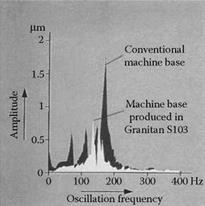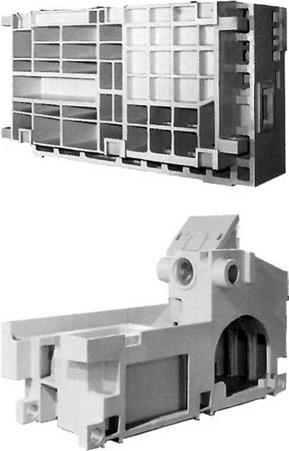A detailed discussion of machine tool design is beyond the scope of this book. The following sections highlight some important features in the design and construction of grinding machines and their elements. For a more detailed discussion, there are publications dedicated to this field such as Slocum [1992].
15.1 THE MACHINE BASE 15.1.1 Introduction
The machine base of a grinder is the most fundamental element on which all the active and passive assemblies are carried. It must be rigid, yet deform elastically, must inhibit vibration, survive in a hostile shop environment, and be thermally stable or at least have predictable thermal properties. Construction is usually based either on a casting or weldments, and selection is generally based on cost and/or application.
15.1.2 Cast Iron Bases
Class 40 cast iron (40,000 psi tensile strength) is the traditional material and still viewed by many original equipment manufacturers (OEMs) as the best material for a machine tool base. Castings have a good stiffness-to-weight ratio and good damping qualities. The material is inexpensive and easy to mold in required shapes to include coolant ways and runoffs, hydraulic and electrical conduit holes, and honeycombing to further improve weight/stiffness ratio.
Some problems with castings are that they require a pattern and that they must be stress-relieved; both of which can be very expensive for larger forms. High-production grinders produced in volume, and/or designed to a common base, can absorb these costs. Custom or one-off grinder manufacturers are usually forced to use less expensive alternatives.
15.1.3 Reuse of Cast Bases
The desire for stable cast-iron bases has led to a whole industry of machine tool builders who are referred to as “remanufacturers.” These builders take an old machine tool, strip it down to the cast — iron base that has become extremely stable over its lifetime, and essentially reassemble the grinder using all the latest components of current grinding technology. This should not be confused with “retrofits” of electrical, hydraulic, or lubrication updates to a machine, or a “rebuild,” which is the reworking of particular parts of a grinder to bring it up, at best, to the original OEM specification.
15.1.4 Welded Bases
Where cast iron is impracticable from a cost point of view several alternatives are used normally based around welded steel. This material has a higher modulus and strength than cast iron so machine tool builders will weld steel sections together with ribbing to provide additional stiffness. Weld joints add some vibration damping and each additional rib weld will also add mass where required. Nevertheless simple steel weldments have considerably less damping
|
|
S S |
Comparision of the vibration-dampening properties |
|||||||||||
|
t |
||||||||||||
|
Graugu в GG-20 |
||||||||||||
|
Micro-gr |
anit |
|||||||||||

ability than cast iron. This can be improved slightly by pumping coolant through ducting, which also aids thermal stability.

